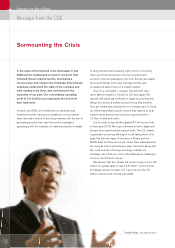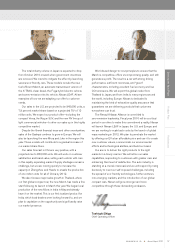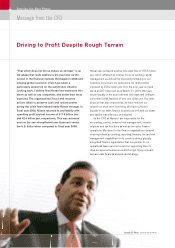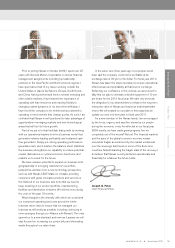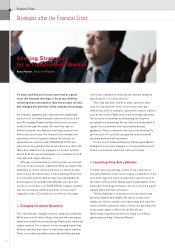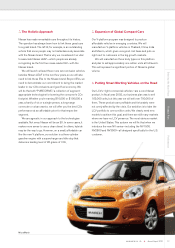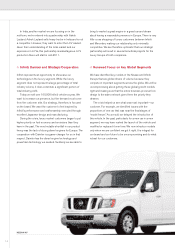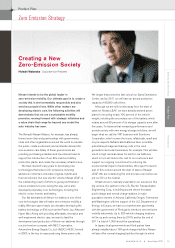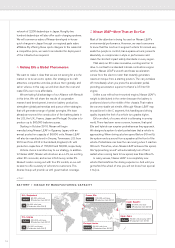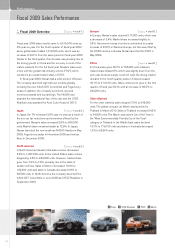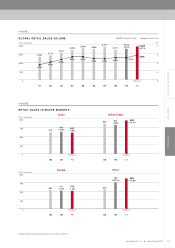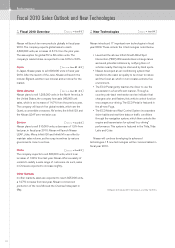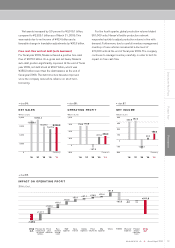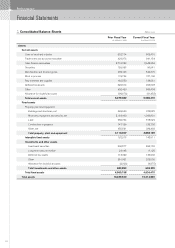Nissan 2010 Annual Report Download - page 18
Download and view the complete annual report
Please find page 18 of the 2010 Nissan annual report below. You can navigate through the pages in the report by either clicking on the pages listed below, or by using the keyword search tool below to find specific information within the annual report.
16
network of 2,200 dealerships in Japan. Roughly two
hundred dealerships will also offer quick-charging systems.
We will commence sales of Nissan-developed in-house
quick chargers in Japan through our regional parts sales
affiliates. By offering these quick chargers to the market at
a competitive price, we seek to accelerate the deployment
of the infrastructure required.
Making EVs a Global Phenomenon
We want to make it clear that we are not aiming for a niche
market or to be an exotic option. Our strategy is to craft
attractive, competitive vehicles, produce them globally, and
sell in volume. In this way, we will drive down the cost and
make EVs even more affordable.
We are taking full advantage of our Alliance with Renault
in this drive. We will share the results of cooperative
research and development, invest on battery production,
strengthen global partnerships and pursue other strategies
that will generate a range of global synergies. We have
already announced the construction of five battery plants in
the U.S., the U.K., France, Japan and Portugal. Our plan is to
produce up to 500,000 batteries a year.
Starting in October 2010, Nissan will begin
manufacturing Nissan LEAF in Oppama, Japan, with an
annual production capacity of 50,000 units. Nissan LEAF
will also be manufactured in Smyrna, Tennessee, U.S. from
2012 and from 2013 in Sunderland, England, U.K. with
production capacities of 150,000 and 50,000, respectively.
Vehicle choice is another key to our strategy. In addition
to Nissan LEAF, Nissan will introduce an e-LCV, an exciting
urban EV commuter, and a new Infiniti luxury sedan EV.
Renault is also coming out with four EV models, so we will
be able to offer a variety of vehicles to customers. This
diverse lineup will provide us with great market coverage.
Nissan LEAF—More Than an Eco-Car
Most of the attention is being focused on Nissan LEAF’s
environmental performance. However, we want consumers
to know that this is a true C-segment vehicle for normal use,
seats five people in comfort, has a spacious trunk, presents
absolutely no compromise in style or performance and
clears the strictest impact safety standards in every region.
That said, our EV is also innovative, exciting and fun to
drive. In contrast to a standard internal-combustion engine
vehicle, Nissan LEAF’s smooth and linear acceleration
comes from the electric motor that instantly generates
maximum torque from a starting position. The car just takes
off immediately when you press the accelerator pedal,
providing acceleration superior to that of a 3.5-liter V6
engine.
Unlike a car with a front-mounted engine, Nissan LEAF’s
weight is distributed in the center because the battery is
positioned close to the middle of the chassis. That makes
the car very stable yet nimble. Although Nissan LEAF may
be positioned in the C segment, this handling and driving
quality imparts the feel of a vehicle two grades higher.
EVs run silent, of course, which is a blessing in a noisy
world. There has been some concern, however, that quiet
EVs and hybrids can surprise pedestrians as they approach.
We designed a system to alert pedestrians that a vehicle is
approaching. When driving at a low speed (below 30 km/h),
the system emits a sound from a speaker at the front of the
vehicle. Pedestrians can hear the car moving when it reaches
30 km/h. Therefore, when Nissan LEAF achieves this speed,
this “approaching sound” will automatically turn off and
restart when coming back to low speed, less than 25km/h.
In many senses, Nissan LEAF is a completely new
vehicle that redefines the driving experience. And until you
get behind the wheel of one, you will not know how special
it truly is.
BATTERY / NISSAN EV MANUFACTURING CAPACITY
Chart:
Japan, Oppama
EV 50,000 units/year
(Production from 2010)
Portugal, Aveiro
Battery 50,000 units/year
(Production from 2012)
Japan, Zama
Battery 90,000 units/year by 2011
(Production from 2010)
U.S., Smyrna
Battery 200,000 units/year
(Production from 2012)
EV 150,000 units/year
(Production from 2012)
France, Flin
Battery 100,000 units/year
(Production from 2012)
U.K., Sunderland
Battery 60,000 units/year
(Production from 2012)
EV 50,000 units/year
(Production from 2013)


